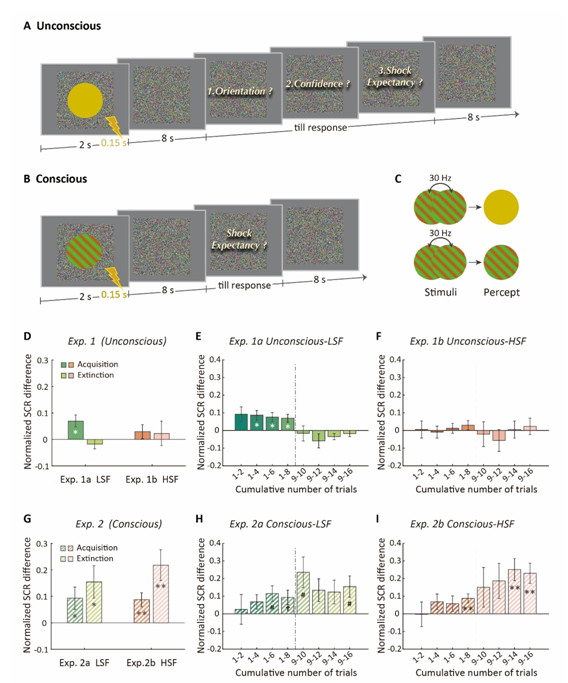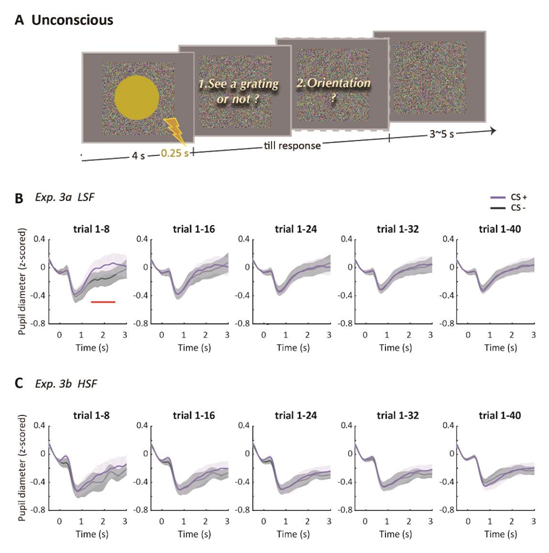Humans have evolved a remarkable ability to effortlessly learn which stimuli in their environment predict potential threats, enabling them to survive in the complex world. According to the widely accepted Preparedness Theory, one can learn the association between emotionally prepared stimuli (e.g., fearful faces) and negative outcome (such as electric shocks) even when these stimuli are outside of conscious awareness.
A collaborative research team, led by Prof. JIANG Yi and Prof. WANG Liang from the Institute of Psychology of the Chinese Academy of Sciences (CAS), has challenged this widely accepted theory, suggesting that the unconscious fear conditioning does not necessarily entail emotionally prepared stimuli, but heavily relies the spatial frequency of the stimuli.
The study was published in Research on June 27th.
The spatial frequency component is a critical but rarely explored factor in unconscious fear conditioning. Many studies have convergently shown that the processing of threat-related stimuli might predominantly rely on the low-spatial-frequency (LSF) components. However, it remains unknown whether the spatial frequency also plays an important role in the successful unconscious acquisition of conditioned fear.
The researchers used emotionally neutral grating stimuli as conditioned stimuli (CSs) and manipulated their spatial frequencies. Simultaneously, they employed the Critical Flicker-Fusion Frequency (CFF) paradigm to manipulate the visibility of the stimuli. Electric shocks served as the unconditioned stimuli (US). By Measuring skin conductance (Figure 1 A-C) and pupil responses (Figure 2 A) in a series of experiments, the present study provides compelling evidence that the unconscious fear learning of emotionally neutral stimuli largely relies on the LSF components.
Emotionally neutral CS+ (associated with a negative outcome) with LSF, but not with high spatial frequency (HSF), elicited stronger skin conductance responses (SCRs) and greater pupil diameters compared to CS- (not associated with a negative outcome). Additionally, unconscious fear associations were rapidly acquired within a few trials but gradually habituated as the conditioning progressed (Figure 2 B). Once the US was removed, the established fear conditioning rapidly diminished (Figure 1 E). In contrast, consciously perceived HSF and LSF stimuli evoked similar differences in SCRs (Figure 1 G). Moreover, fear conditioning occurred slowly, and the conditioned fear was retained for several trials after the removal of the unconditioned stimulus (Figure 1 H-I).
This study provides robust evidence that unconscious emotionally neutral stimuli can be efficiently associated with a negative outcome. It further demonstrates that the unconscious fear processing relies more on the LSF information, while the conscious fear processing has no apparent preference for spatial frequency. In addition, the study confirms that pupil responses are as sensitive as skin conductance responses and can serve as effective physiological measures for assessing unconscious fear conditioning in humans. In conclusion, these findings provide new insights into the mechanisms of unconscious fear learning, revealing the critical role of spatial frequency in the conditioning process. Moreover, they add to the comprehensive understanding of anxiety disorders or phobias.
This work was funded by the STl2030-Major Projects, the National Natural Science Foundation of China, the Strategic Priority Research Program, the CAS Interdisciplinary Innovation Team, and the Fundamental Research Funds for the Central Universities.

Figure 1 Procedure, stimuli, and results of SCRs. Image by CHEN Yujie.

Figure 2 Procedure and results of pupillary responses. Image by CHEN Si.
LIU Chen
Institute of Psychology Chinese Academy of Sciences
Beijing 100101, China.
E-mail: liuc@psych.ac.cn
